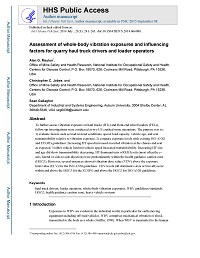Mining Publication: Assessment of Whole-body Vibration Exposures and Influencing Factors for Quarry Haul Truck Drivers and Loader Operators
Original creation date: July 2014
Authors: AG Mayton, CC Jobes, S Gallagher
To further assess vibration exposure on haul trucks (HTs) and front-end wheel loaders (FELs), follow-up investigations were conducted at two US crushed stone operations. The purpose was to: 1) evaluate factors such as load/no-load conditions, speed, load capacity, vehicle age, and seat transmissibility relative to vibration exposure; 2) compare exposure levels with existing ISO/ANSI and EUGPG guidelines. Increasing HT speed increased recorded vibration at the chassis and seat as expected. Neither vehicle load nor vehicle speed increased transmissibility. Increasing HT size and age did show transmissibility decreasing. HT dominant-axis wRMS levels (most often the y-axis, lateral or side-to-side direction) were predominantly within the health guidance caution zone (HGCZ). However, several instances showed vibration dose value (VDV) above the exposure limit value (ELV) for the ISO/ANSI guidelines. VDV levels (all dominant x-axis or fore-aft) were within and above the HGCZ for the EUGPG and above the HGCZ for ISO/ANSI guidelines.
- Characteristics of Fugitive Dust Generated from Unpaved Mine Haulage Roads
- Comparison of Whole-Body Vibration Exposures on Older and Newer Haulage Trucks at an Aggregate Stone Quarry Operation
- Engineered Solutions - Dump Truck Vibrations and Impact on Operator Safety in High-Impact Shovel Loading Operations
- Evaluation of the Approach to Respirable Quartz Exposure Control in U.S. Coal Mines
- Investigation of Human Body Vibration Exposures on Haul Trucks Operating at U.S. Surface Mines/Quarries Relative to Haul Truck Activity
- Laboratory Investigation of Seat Suspension Design Performance during Vibration Testing
- Physiological Responses and Subjective Discomfort of Simulated Whole-Body Vibration From a Mobile Underground Mining Machine
- Test Results of Collision Warning Systems for Surface Mining Dump Trucks
- Tying Acceleration and GPS Location Information Together To Create a Mine Management Tool
- Whole-Body Vibration Exposure Comparison of Seat Designs for Low- and Mid-Seam Shuttle Cars in Underground Coal Mines
